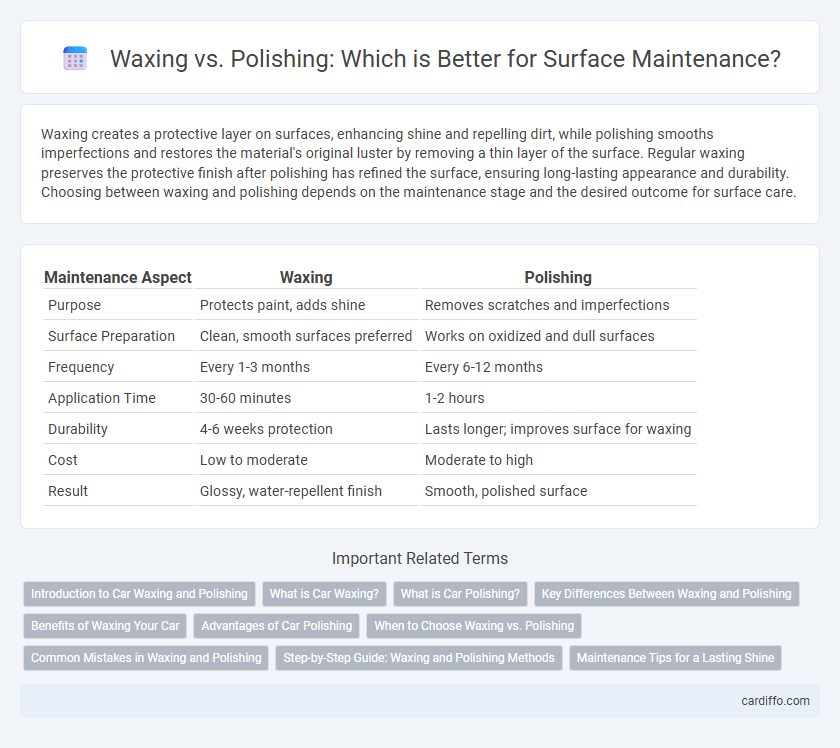Waxing creates a protective layer on surfaces, enhancing shine and repelling dirt, while polishing smooths imperfections and restores the material's original luster by removing a thin layer of the surface. Regular waxing preserves the protective finish after polishing has refined the surface, ensuring long-lasting appearance and durability. Choosing between waxing and polishing depends on the maintenance stage and the desired outcome for surface care.
Table of Comparison
| Maintenance Aspect | Waxing | Polishing |
|---|---|---|
| Purpose | Protects paint, adds shine | Removes scratches and imperfections |
| Surface Preparation | Clean, smooth surfaces preferred | Works on oxidized and dull surfaces |
| Frequency | Every 1-3 months | Every 6-12 months |
| Application Time | 30-60 minutes | 1-2 hours |
| Durability | 4-6 weeks protection | Lasts longer; improves surface for waxing |
| Cost | Low to moderate | Moderate to high |
| Result | Glossy, water-repellent finish | Smooth, polished surface |
Introduction to Car Waxing and Polishing
Car waxing creates a protective layer on the paint surface, enhancing shine while repelling water and contaminants. Polishing involves removing a thin layer of the clear coat to eliminate scratches and oxidation, restoring the paint's smoothness and clarity. Both processes are essential for maintaining vehicle aesthetics, with waxing providing protection and polishing improving surface quality.
What is Car Waxing?
Car waxing involves applying a protective layer of wax to the vehicle's paint surface, enhancing its shine and creating a hydrophobic barrier that repels water and contaminants. This process helps preserve the clear coat, preventing oxidation and fading caused by UV rays and environmental pollutants. Waxing differs from polishing by focusing primarily on protection and gloss rather than removing scratches or imperfections.
What is Car Polishing?
Car polishing is a maintenance process that uses abrasive materials to remove surface imperfections such as scratches, oxidation, and swirl marks, restoring the vehicle's paint to a smooth, glossy finish. It enhances the car's appearance by leveling the clear coat and preparing it for protective treatments like waxing. Polishing penetrates deeper than waxing, addressing paint defects and improving overall shine and clarity.
Key Differences Between Waxing and Polishing
Waxing creates a protective layer on a surface to guard against moisture, dirt, and UV damage, while polishing removes surface imperfections like scratches and oxidation to restore shine. Waxing typically lasts longer by sealing the surface, whereas polishing provides an immediate smooth appearance but requires more frequent application. The main difference lies in waxing being a protective measure, whereas polishing is a corrective process to improve surface texture and appearance.
Benefits of Waxing Your Car
Waxing your car creates a protective barrier that shields the paint from UV rays, road salt, and environmental contaminants, extending the vehicle's lifespan. It enhances the paint's gloss and depth, resulting in a vibrant, showroom-quality finish. Regular waxing reduces minor scratches and water spots, making maintenance easier and preserving the car's resale value.
Advantages of Car Polishing
Car polishing enhances the vehicle's paint by removing minor scratches, oxidation, and swirl marks, resulting in a smoother and shinier surface. It restores the paint's clarity and depth by removing a thin layer of clear coat, which improves light reflection and overall appearance. Polishing also prepares the surface for better wax adhesion, extending the protection and longevity of the paintwork.
When to Choose Waxing vs. Polishing
Waxing is ideal for protecting the paint surface and enhancing shine on cars with minor imperfections or freshly polished finishes, typically recommended every few months. Polishing should be chosen when there are visible scratches, oxidation, or surface irregularities, as it removes a thin layer of clear coat to restore smoothness and color depth. Regular assessment of paint condition helps determine whether waxing for protection or polishing for correction is necessary.
Common Mistakes in Waxing and Polishing
Common mistakes in waxing include applying wax on a hot or dirty surface, leading to uneven coverage and reduced protection. Over-polishing can cause clear coat damage, creating swirl marks and compromising paint integrity. Using inappropriate products or skipping surface preparation further diminishes the effectiveness of both waxing and polishing processes.
Step-by-Step Guide: Waxing and Polishing Methods
Waxing involves applying a thin layer of wax to the surface, allowing it to dry, then buffing it to enhance shine and create a protective barrier against environmental elements. Polishing requires using a fine abrasive compound to remove surface imperfections such as scratches and oxidation, restoring the paint's smoothness and clarity before applying wax for protection. Following these step-by-step methods maintains vehicle aesthetics and prolongs the durability of the paint finish.
Maintenance Tips for a Lasting Shine
Regular waxing provides a protective barrier that shields your vehicle's paint from environmental contaminants and UV damage, enhancing its durability and shine. Polishing removes surface imperfections like scratches and oxidation, restoring the paint's smoothness and reflective quality but should be done sparingly to avoid thinning the clear coat. For lasting shine, apply wax every 3 months and polish only when necessary, followed by thorough cleaning to maintain optimal surface condition.
Waxing vs Polishing Infographic

 cardiffo.com
cardiffo.com